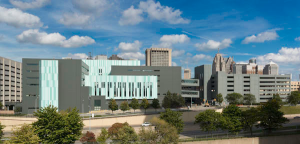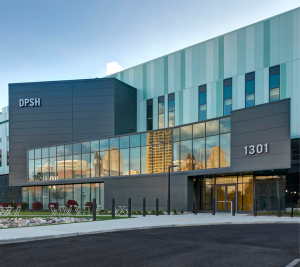In his 2011 State of the City address, Mayor Dave Bing noted that Detroit is a “work in progress”. However, he believed several initiatives would provide measurable improvements for the city. Among Bing’s goals was to bring together Detroit’s public-safety teams—police, fire, emergency services and the Michigan State Police Crime Lab—into one headquarters building. Not only would the consolidation bring about communication efficiencies and cost savings, but it also would provide an improved, secure facility for many of Detroit’s finest.

To minimize construction costs and invest in Detroit’s existing infrastructure, the mayor and his team opted to retrofit an existing building. But where would they find a building that would suit the needs of Detroit’s first responders? The structure would have to house around 700 employees, provide room for growth, be adaptable for the forensics lab’s intense infrastructure requirements, offer shared circulation for collaboration between departments and be welcoming to citizens.
According to Bill Ash, AIA, LEED AP, design principal for SmithGroupJJR’s Detroit office, location and unique building characteristics led the site-selection team to a 450,000-square-foot concrete fortress, clad in single-skin metal panels and EIFS, sited prominently along the Lodge Freeway, one of the main arteries leading from the north and west suburbs into downtown Detroit. Although structurally sound, the building would present a few unexpected challenges during its metamorphosis into the city’s symbol of strength.
Decisions
Built in 1974 as an Internal Revenue Service data center, the mammoth building had acted as a temporary casino for MGM Grand Detroit from 1995-2005. Then the structure was abandoned until 2010 when Detroit bought it for $6.3 million. Its location was one of the most important factors that led to the city’s decision to purchase the building and use it as the public-safety headquarters. “It’s still downtown, and downtown is certainly in a resurgence right now; there’s a lot of investment coming back into it,” Ash explains. “The building had been kind of this abandoned hulk since the casino left— very prominent and visible. Because of the location, it was an opportunity to reinvest in downtown and generate some new activity in that part of the city.”

Coincidentally, a few characteristics from the structure’s varied IRS and MGM history ensured it would make a good home for the public-safety teams. It offered ample parking and drive-up areas for vehicle inspections, as well as a large existing onsite generator. “Another of these characteristics was the primary gaming floor—once the IRS’s computer floor,” Ash adds. “That very big, double-height space allowed us to meet the forensics’ mechanical and electrical requirement within the envelope pretty efficiently.”
In addition, the upper portion of the building is organized into two towers with a shared central core that fit nicely with the stakeholders’ open-office concept. “There were opportunities where the two towers come together into a circulation core for overlap and collaboration space, bringing together police and fire, in particular,” Ash notes.
Despite the many characteristics that made the building an ideal choice for the Detroit Public Safety Headquarters, there were many changes needed to guarantee the space met the city’s needs. A strong partnership between White Turner Construction (a collaboration of the Detroit locations of White Construction and Turner Construction Co.), the Detroit Building Authority, stakeholders, Ash and his team, engineers, site planners and landscape architects ensured the building could be transformed into a state-of-the-art facility.


